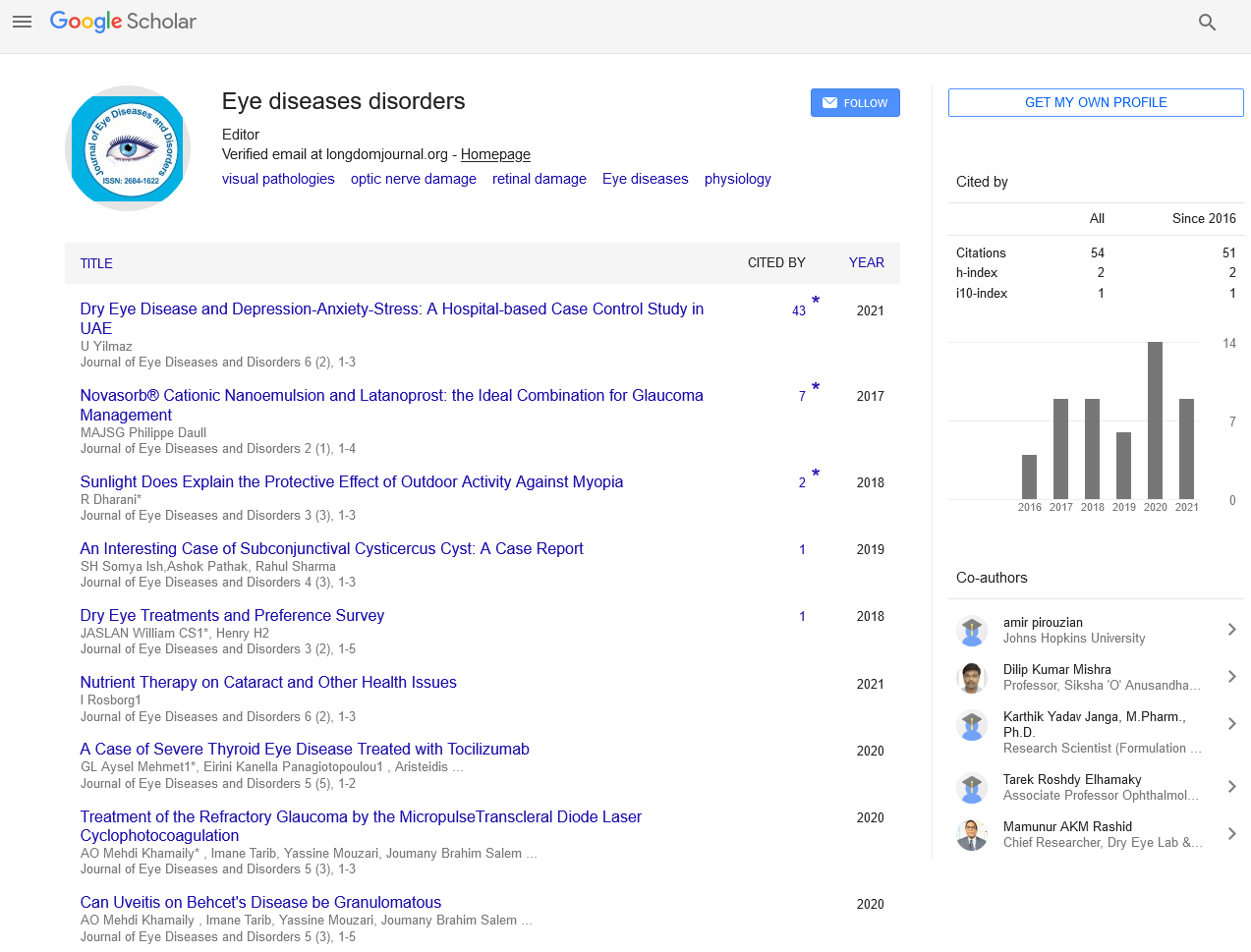Indexed In
- RefSeek
- Hamdard University
- EBSCO A-Z
- Geneva Foundation for Medical Education and Research
- Euro Pub
- Google Scholar
Useful Links
Share This Page
Journal Flyer
Open Access Journals
- Agri and Aquaculture
- Biochemistry
- Bioinformatics & Systems Biology
- Business & Management
- Chemistry
- Clinical Sciences
- Engineering
- Food & Nutrition
- General Science
- Genetics & Molecular Biology
- Immunology & Microbiology
- Medical Sciences
- Neuroscience & Psychology
- Nursing & Health Care
- Pharmaceutical Sciences
Short Communication - (2020) Volume 5, Issue 6
Deficits in considering Visual rehabilitation
Mehadi Khamayli*Received: 19-Nov-2020 Published: 10-Dec-2020, DOI: 10.35248/2684-1622.5.6.147
Description
In everyday life, our minds cycle a lot of visual data and concentrate spatiotemporal highlights, for example, shape, shading, profundity, speed, and movement bearing, proficiently progressively. Along these lines, typical vision not just alludes to a visual sharpness of 20/20, yet in addition great execution in an assortment of complex visual undertakings.
Typical vision can be disturbed by numerous visual sicknesses, for example, refractive blunder, amblyopia, strabismus, waterfall, glaucoma, age-related macular degeneration, and visual weariness [1]. Much of the time, upset visual execution can't just be clarified by the natural pathology, and the vision misfortune may stay even after the illness has been clinically treated. In this Research Topic, we look to feature vision problems that influence the entire visual pathway, giving not just a model to the unusual visual framework yet additionally help in our comprehension of the visual neural framework.
From the clinical viewpoint, understanding vision issues is basic to the checking, avoidance, conclusion, and mediation of practical eye illnesses. This can be refined with the advancement of new techniques for evaluating a scope of visual capacities including contrast affectability, stereopsis, interocular concealment, visual fields, and visual engine work in a more exact and time-productive way [2]. For instance, amblyopia is a typical utilitarian eye illness that used to be viewed as a latent visual misfortune, i.e., "lethargic eye". As of late, lab based tests utilizing visual psychophysics ideal models and neuroimaging strategies feature the function of dynamic interocular concealment in amblyopia. There is additionally proof that binocular visual shortages are more pertinent to patients' personal satisfaction than diminished best- amended visual keenness [3]. These on-going advances are basic for our comprehension of amblyopia and have changed the focal point of amblyopia medicines.
Because of the solid association between vision issues and the cerebrum, abusing the capability of mind versatility to recuperate vision in different useful eye issues is at present perhaps the most blazing region in neuroscience. Strategies for recuperation incorporate visual perceptual learning, visual transformation, light hardship, and the appraisal of procedures for inciting visual cortex neuroplasticity that consolidates drugs, non-obtrusive cerebrum incitement, and exercise [4]. Investigating the wildernesses of neural versatility could enormously progress visual recovery in facilities. Dissimilar to customary medicines that attention on the eye, for example, medical procedure or refractive adjustment, the acceptance of neural pliancy in visual recovery is non-careful, non- obtrusive, and possibly dependable. It very well may be considered as a 'neuronal revision' that straightforwardly focuses on the visual deficiencies in various visual assignments [5].
Investigation into visual shortages and recovery has advanced our insight into useful eye infections. More work zeroing in on the visual capacity range is expected to additional our comprehension of various practical eye infections, for instance, the clinical importance of various visual shortfalls, the fundamental neural systems of vision misfortune, and grown-up visual pliancy.
REFERENCES
- Roche O, Kaplan J Congenital and megalocorneal glaucoma. J Med Childhood. 1996;5:43-48.
- DetrY-morel M Congenital glaucoma. Bull Soc Belgian Ophthalmol. 2001;281:49-58.
- Mandal AK, Chakrabarti D Update on congenital glaucoma. Indian J Ophthalmol. 2011;59(7):148.
- Demailly P, Dhermy P Les glaucomes congénitaux. Encycl Med Chir Ophthalmology. 1981;212(80):1-15.
- Khaw PT What is the best primary surgical treatment for the infantile glaucomas? Br J Ophthalmol. 1996;80(6):495.
Citation: Khamayli M (2020) Deficits in considering Visual rehabilitation. J Eye Dis Disord. 5:147.
Copyright: © 2020 Khamayli M. This is an open-access article distributed under the terms of the Creative Commons Attribution License, which permits unrestricted use, distribution, and reproduction in any medium, provided the original author and source are credited.

